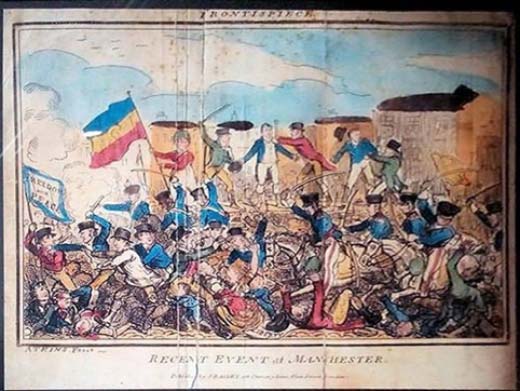Local History Society Report
The massacre of Peterloo – "it was downright murder"
Remembering Peterloo by Alan Fowler
Tuesday, 19 March 2019
A sunny Monday, 200 years ago, on August 16th, 1819 in Manchester. A peaceful, lively meeting of 60,000 men, women and children, calling for ‘manhood suffrage’ and political reform. The cavalry charged with sabres drawn. By the end of the day, 15 were dead, including 4 women and a child of two, and as many as 600 injured.

At another well-attended lecture for the Hebden Bridge Local History Society, these awful events were brought vividly to life by society member, Alan Fowler. Alan, formerly Principal Lecturer of Economic and Social History at Manchester Metropolitan University, drew on a rich collection of contemporary prints and cartoons to build up the context behind the event and the panic and confusion of the day itself.
The background was one of economic distress after the Napoleonic wars, high bread prices following the Corn Laws, and political frustration as the town’s population, having reached 100,000, still lacked even a single MP to address the problems of industrial growth. 15,000 had already attended a meeting in January 1819, resulting in the abortive march of the ‘Blanketeers’ to London. This time the hand-loom weavers and millworkers of the industrial districts around Manchester came in force, and the Manchester Tory landowners and magistrates, alerted by spies, mobilised the Manchester Yeomanry as well as summoning regular cavalry units such as the 15th Hussars.
Alan pointed out that almost nothing is left of St Peter’s Field, a large open space near the modern St Peter’s Square tram stop, which is sited immediately above the crypt of the old church. But is was easy to imagine the panic as the Manchester Yeomanry charged through the crowd to arrest the main speaker, Henry Hunt, slashing as they went. The watching magistrates then ordered in the regulars who made matters worse. It was an event bound to cause rioting, which continued across the Manchester area for two days.
Alan contrasted the obvious horror of the day with the long campaign to come to terms with the event. The name Peterloo stuck, an ironic coinage just four years after the Waterloo – and Alan cited the words of John Lees, a witness of both events, who died a month later: “At Waterloo there was man to man, but at Manchester, it was downright murder.”
The immediate aftermath was prosecution of Hunt and several prominent radicals, including the Middleton weaver and writer, Samuel Bamford. Repression led to the imprisonment of all the leading radicals and the Six Acts, and a tax of 4d on periodicals.
The only public memorial in Manchester is a red plaque on the wall of the former Free Trade Hall, now the Radisson Hotel on Peter Street. In 2007, the plaque was replaced to emphasise the brutality of the day. A mural from 1951 inside the hotel is hidden away. Commemorative events are expected later in this bicentenary year.
To warm applause, President of the society, Barbara Atack, thanked Alan for a memorable evening.
The next meeting of the Hebden Bridge Local History Society on Wednesday 27th March will have a very local focus, as Anne Mealia, genealogist and historical researcher explores Life and Death in Hebden Bridge 1851 – 1901, drawing on census information.
With thanks to Murray Seccombe (Secretary) for this report
Details of all the Society’s activities can be found on the website and you can also follow them on their Facebook page.
See also


